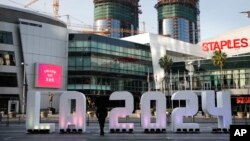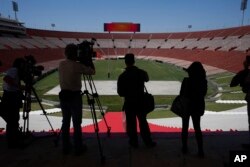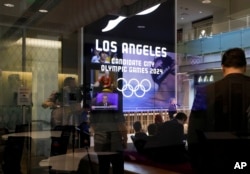Evaluating Los Angeles' readiness to host the 2024 Olympic Games takes some imagination. That's because a lot of the pitch still relies on images on a computer screen, or a blueprint of what's to come on a dusty construction site.
Los Angeles Olympic organizers often say their plan for two weeks of international competition is virtually realized, stressing that it requires no new construction of permanent venues. The concept for the L.A. Games, they say, is ready to go because "it already exists."
But there is a lot that International Olympic Committee members won't see as they visit Los Angeles this week in the run-up to a September decision on whether L.A. or Paris will get the 2024 Games.
Some of the opening ceremonies, including the famous Parade of Nations, would take place in a $2.6 billion NFL stadium just outside Los Angeles that today is a gouged, fenced-in lot crisscrossed by tire tracks.
The city notorious for its clotted freeway traffic will make use of a "growing public transit system," the L.A. proposal boasts. Indeed, Los Angeles has billions of dollars of planned rail lines, but how many will be ready for the Games in seven years is largely a guess, given the uncertainties that come with major construction projects. Some aren't scheduled to be completed until 2023 and 2024.
City planners describe the Los Angeles International Airport as the "gateway" for the Olympics. But anyone familiar with the airport knows it inflicts daily misery on travelers, including knotted traffic in and out of terminals. An impressive new terminal opened several years ago for international flights, but many others feel like a walk into a grimy past. Billions of dollars in improvements are planned.
'The ability to deliver'
L.A.'s bid is closer to completion than many in past years, but in many ways it comes down to a promise of what's to come.
This week, IOC members are looking for "the ability to deliver," said Chicago-based sports finance consultant Marc Ganis. They want to see "commitment and competence," he said, not just sketches and mock-ups.
On Thursday, members of the IOC fanned out in several groups to privately tour the proposed venues, including the Rose Bowl, the site for soccer matches.
In the background is a looming question. The IOC is considering awarding two Olympics at its September meeting in Peru, 2024 and 2028, one for each city. Officials from both cities stress they are bidding on 2024.
On Wednesday, Patrick Baumann, chairman of the IOC evaluation committee, didn't directly address a question about the possibility of awarding the 2024 and 2028 Games at the same time.
"We will be concentrating on the process that has started and these cities have been going through for the purpose of awarding the host of 2024," Baumann told reporters.
In the Olympics, time is the enemy. As late as March 2000, the IOC considered moving the 2004 Olympics out of Athens, Greece, because of construction delays. Even so, work on the main stadium complex was ongoing just weeks before the Games began.
There are six events planned for Long Beach, a coastal city south of downtown L.A. However, most of them will require temporary facilities that don't exist today, including a water polo pool.
Projected costs
The cost of making it a reality can be substantial. Erecting and removing the temporary pool and bleachers, for example, is projected at nearly $14 million. A mountain biking track in the hills east of Los Angeles will cost over $13 million. A temporary outdoor stadium would rise next to the famous Santa Monica pier for volleyball. Cost: $23.4 million.
Even sites that do exist, like the iconic Los Angeles Memorial Coliseum, home to the 1932 and 1984 Olympics, are works in progress.
It's slated to have a $270 million renovation completed by 2019, but transforming a football stadium into a venue for Olympic track events, then back again, will cost over $100 million, according to projections.
A little stagecraft can help fill in what's missing. At the Rose Bowl, organizers emblazoned the field with the Olympic rings for their IOC guests. Hollywood studios were illuminated with the colors of an L.A. sunset and the logo for the city's bid to mark the arrival of the IOC. Committee members attended a celebrity-studded dinner Wednesday where guests included retired Lakers great Kobe Bryant, Spanish tenor Placido Domingo and actor Sylvester Stallone.
"A lot of the stadiums for the Olympics are being envisioned for the future. They would not even be built if it wasn't for the Olympics," said Jules Boykoff, a professor at Pacific University in Oregon who has written widely on the Olympics movement.
"If you have existing venues, you don't have to envision as much. It still takes some imagination," he said.









